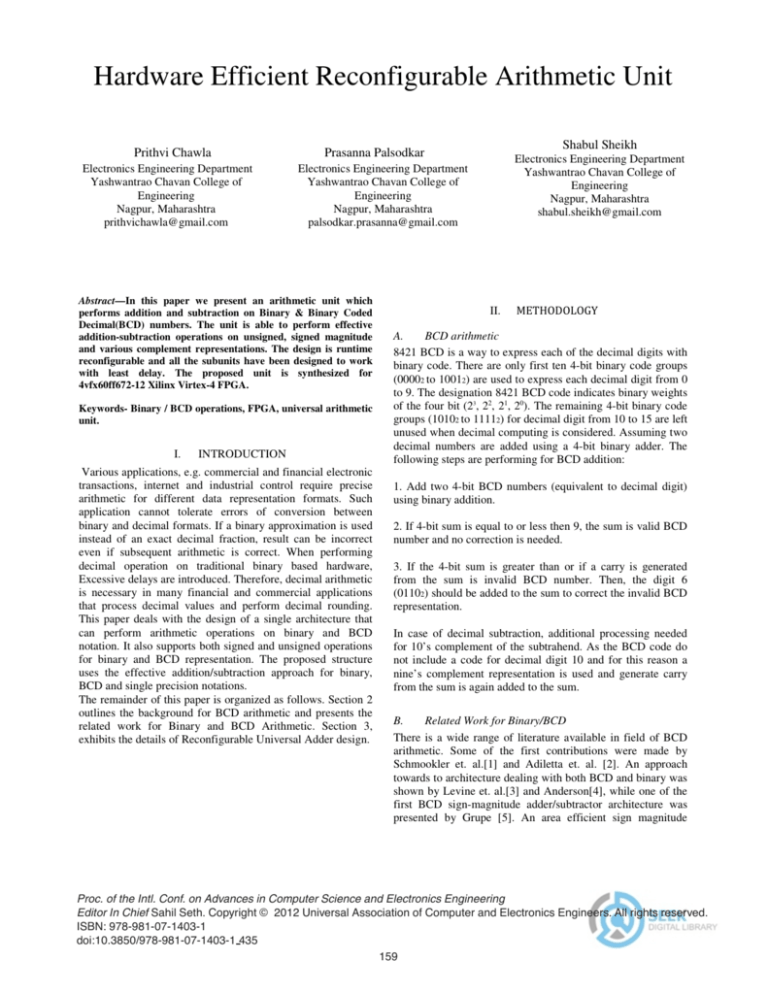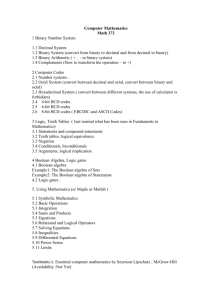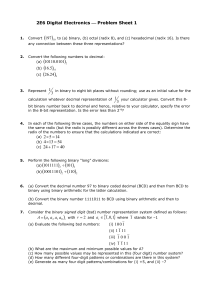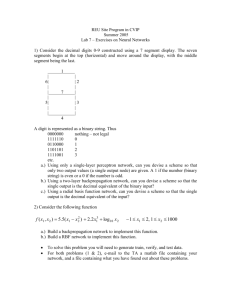
Hardware Efficient Reconfigurable Arithmetic Unit
Prithvi Chawla
Electronics Engineering Department
Yashwantrao Chavan College of
Engineering
Nagpur, Maharashtra
prithvichawla@gmail.com
Electronics Engineering Department
Yashwantrao Chavan College of
Engineering
Nagpur, Maharashtra
shabul.sheikh@gmail.com
Electronics Engineering Department
Yashwantrao Chavan College of
Engineering
Nagpur, Maharashtra
palsodkar.prasanna@gmail.com
Abstract—In this paper we present an arithmetic unit which
performs addition and subtraction on Binary & Binary Coded
Decimal(BCD) numbers. The unit is able to perform effective
addition-subtraction operations on unsigned, signed magnitude
and various complement representations. The design is runtime
reconfigurable and all the subunits have been designed to work
with least delay. The proposed unit is synthesized for
4vfx60ff672-12 Xilinx Virtex-4 FPGA.
Keywords- Binary / BCD operations, FPGA, universal arithmetic
unit.
I.
Shabul Sheikh
Prasanna Palsodkar
INTRODUCTION
Various applications, e.g. commercial and financial electronic
transactions, internet and industrial control require precise
arithmetic for different data representation formats. Such
application cannot tolerate errors of conversion between
binary and decimal formats. If a binary approximation is used
instead of an exact decimal fraction, result can be incorrect
even if subsequent arithmetic is correct. When performing
decimal operation on traditional binary based hardware,
Excessive delays are introduced. Therefore, decimal arithmetic
is necessary in many financial and commercial applications
that process decimal values and perform decimal rounding.
This paper deals with the design of a single architecture that
can perform arithmetic operations on binary and BCD
notation. It also supports both signed and unsigned operations
for binary and BCD representation. The proposed structure
uses the effective addition/subtraction approach for binary,
BCD and single precision notations.
The remainder of this paper is organized as follows. Section 2
outlines the background for BCD arithmetic and presents the
related work for Binary and BCD Arithmetic. Section 3,
exhibits the details of Reconfigurable Universal Adder design.
II.
A.
BCD arithmetic
8421 BCD is a way to express each of the decimal digits with
binary code. There are only first ten 4-bit binary code groups
(00002 to 10012) are used to express each decimal digit from 0
to 9. The designation 8421 BCD code indicates binary weights
of the four bit (23, 22, 21, 20). The remaining 4-bit binary code
groups (10102 to 11112) for decimal digit from 10 to 15 are left
unused when decimal computing is considered. Assuming two
decimal numbers are added using a 4-bit binary adder. The
following steps are performing for BCD addition:
1. Add two 4-bit BCD numbers (equivalent to decimal digit)
using binary addition.
2. If 4-bit sum is equal to or less then 9, the sum is valid BCD
number and no correction is needed.
3. If the 4-bit sum is greater than or if a carry is generated
from the sum is invalid BCD number. Then, the digit 6
(01102) should be added to the sum to correct the invalid BCD
representation.
In case of decimal subtraction, additional processing needed
for 10’s complement of the subtrahend. As the BCD code do
not include a code for decimal digit 10 and for this reason a
nine’s complement representation is used and generate carry
from the sum is again added to the sum.
B.
Related Work for Binary/BCD
There is a wide range of literature available in field of BCD
arithmetic. Some of the first contributions were made by
Schmookler et. al.[1] and Adiletta et. al. [2]. An approach
towards to architecture dealing with both BCD and binary was
shown by Levine et. al.[3] and Anderson[4], while one of the
first BCD sign-magnitude adder/subtractor architecture was
presented by Grupe [5]. An area efficient sign magnitude
Proc. of the Intl. Conf. on Advances in Computer Science and Electronics Engineering
Editor In Chief Sahil Seth. Copyright © 2012 Universal Association of Computer and Electronics Engineers. All rights reserved.
ISBN: 978-981-07-1403-1
doi:10.3850/978-981-07-1403-1 435
159
Proc. of the Intl. Conf. on Advances in Computer Science and Electronics Engineering
adder was later developed by Hwang [6]. Area occupied by
this design was least amongst all the previous designs.In this
approach two additional conversions are introduced before and
after the binary novelty in Hwang’s proposal comes with the
separation of the binary and the decimal results, using a
multiplexer to select the correct output as is depicted in Figure
1.
The design of the Universal Adder (Fig. 4) proposed by
D.R.Humberto et al. [9] uses effective addition/subtraction
operations on unsigned/sign-magnitude, and various
complement representations. This design overcomes the
limitations of previously reported approaches that produce
some of the results in complement representation when
operating on sign-magnitude numbers. This design proposed
that the major disadvantage of the previous designs i.e. having
the subtrahend the smaller number in magnitude, was
eliminated by their approach. This paper proposed a new
method without the essential use of Inputs Outputs
complement to perform BCD subtraction.
Figure 1. Hwang’s proposal
Fischer et al. [7] (Fig. 2) later came up with a compact design
that employed only one adder but the latency was a problem as
it had to use an additional correction block.This unit encodes
the incoming operands as well as the adder result to achieve
the desired functionality.
Figure 4. Humberto’s Proposal
Sreehari et al. recently came up with the prefix logic based
BCD adders and proposed a novel unified BCD binary addersubtractor [10] which is considered as the fastest unified adder
in the literature so far. The architecture is divided into three
major parts, the pre-computation stage, prefix network and
post computation stage illustrated in Fig.5. The precomputation block consists of logic to compute propagate and
generate signals for both BCD and Binary addition/subtraction
with much lower latency.
Figure 2. Fischer’s proposal
The approach to construct BCD architectures in many IBM
processors is based on the work presented by Haller et. al. in
[8]. This architecture shown in Fig. 3 operated in a single
cycle, though requiring corrections in some cases. In the case
of subtraction there is a need for the computation of the
complement after the subtraction to obtain the correct
difference, hence increasing the latency. Another improvement
in the same architecture was the optimization of the carry
chain resulting in a slight delay improvement with an
increased area of the unit.
Figure 5. Sreehari’s Proposal
III.
PROPOSED REDUCED DELAY UNIVERSAL
ADDER
The whole architecture of the reduced delay universal adder
sub- divided into six subunits. Sixth subunit is Carry in
Figure 3. Haller’s proposal
160
Proc. of the Intl. Conf. on Advances in Computer Science and Electronics Engineering
circuitry for both carry-propagate-adder including Co logic
works parallel to the rest design.
Op = 0
for addition &
Op = 1
for subtraction
Conclusion is that the addition/subtraction of two
unsigned/signed- magnitude numbers can be performed with
the determination of effective operation.
The effective operation can be computed by the following
Boolean expression:
(2)
EOp = (N1n-1۩ N2n-2 ۩ Op)
If EOp is equal to one, effective addition will be performed,
and if EOp is equal to zero, effective subtraction will be
performed. The effective operations are described in Table.1
N1s
N2s
Op
EOp
Operations
0
0
0
1
+(|N1|+|N2|)
0
0
1
0
+(|N1|-|N2|)
0
1
0
0
+(|N1|-|N2|)
0
1
1
1
+(|N1|+|N2|)
1
0
0
0
-(|N1|-|N2|)
1
0
1
1
-(|N1|+|N2|)
1
1
0
1
-(|N1|+|N2|)
1
1
1
0
Table 1
-(|N1|-|N2|)
Figure 6. Proposed Architecture
The first subunit of our proposal includes Eadd logic, XOR
and Digitwise-6 logic while second subunit includes DC logic
and decimal correction coder. Third and fourth subunits are
carry-propagate-adder 1 and carry-propagate-adder 2
respectively. The SUM correction SC logic divides as a fifth
subunit.
In order to perform binary arithmetic, only first, third, and
fifth subunits works together in pipelined manner while sixth
subunit works parallel to the rest units. Digitwise-6 logic,
second and fourth subunits are left unused. And in order to
perform decimal operation, first five subunit works together in
pipelined manner while sixth subunit in parallel. Second
subunit follows first subunit and fourth subunit follows third
subunit.
The main objective of our design was to reduced delay of
binary and BCD adder/subtrator operations using parallelizing
and pipelining scheme. To achieve this we used the Humberto
[9] design as a base. We kept its functionality as it is, with
minimizing its delay. For unsigned and sign-magnitude
addition/subtraction or effective addition/subtraction, we also
use s/370 sign-magnitude adder as a base.
A.
BINARY ARITHMETIC
Let us assume N1 and N2 being two n-bit sign magnitude
numbers, such that N1 = [N1n−1 N1n−2...N10] and N2 =
[N2n−1N2n−2...N20], with N1n−1 and N2n−1 used as sign bits of
binary or BCD representations.
Consider the operation R = N1 Op N2
(1)
with input signal Op indicates desirable addition/ subtraction
operation and R being the result of the operation.
The effective operation i.e.addition/subtraction operation is
performed on the absolute values of N1 and N2, denoted by
|N1| and |N2| respectively, and the operation produces no
overflow.
Assuming that the operation is binary effective addition then
the following equation establishes binary effective addition:
SUM= |N1|+|N2|+ Co
(4)
Where, Co is used to find whether |N1| is greater than |N2| or
less than/equals to |N2|. Co should be equals to zero for
effective addition. Boolean expression for Co can be defined
as following:
Co= G0n-1 [|N1|, |N2|]
=Gn-1| (Pn-1.Gn-2)|...| (Pn-1.Pn-2…Pn-i.Gi)|…..
|(Pn-1.Pn-2……P1.G0)
Where Gi = N1i.N2i and Pi=N1i|N2i are generate and propagate
signals respectively.
Assume that the operation is binary effective addition.Then
the following equation establishes the equation
Σ = |N1|+|N2|
(3)
Assume that the operation is binary effective subtraction. Then
the equation is represented as
Σ= |N1|+|N2|+ Co
(4)
Where Co is used to find whether |N1| is greater than |N2| or
less than/equals to |N2|.
As it is stated that there is no overflow, so Co is given as
161
Proc. of the Intl. Conf. on Advances in Computer Science and Electronics Engineering
Co = G0n-2 [N1,N2]
(5)
Case 1: If |N1|>|N2| then SUM will be positive and the
following equation establishes decimal effective subtraction:
(15)
Σ = |N1|+|N2*|+ 01102+1 (if DC=1)
Where G0n-2 indicates the group generate signal from bit 0 to
bit n-2.Co can be expanded as
Co = Gn-1| (Pn-1.Gn-2)|...| (Pn-1.Pn-2…Pn-i.Gi)|…
(6)
| (Pn-1.Pn-2……P1.G0)
Σ = |N1|+|N2*| + 0 + 0 (if DC=0)
Where ‘*’ indicates nine’s complement of the operand.
Where Gi = N1i.N2i and Pi=N1i|N2i are generate and propagate
signals respectively.
Case 2: if |N1|<|N2| then SUM may be negative and the
following equations establish decimal effective subtraction:
(17)
Σ = |N1|+|N2*|+ 11002 + 0 (if DC=1)
For binary effective subtraction following possibilities can be
defined:
Σ = |N1|+|N2*|+01102 + 0 (if DC=0)
Case 1: If |N1|>|N2| then Σ will be positive and the following
equation establishes binary effective subtraction:
Σ = |N1|+|N2|+ Co
(7)
Where Co =1 because |N1|>|N2| and performs 2’s complement
subtraction.
The digital carry logic (DC) signal for decimal operations are
obtained as follows:
DC=A|B.Cin
(20)
Where
A=G3|P3.P2|P3.P1|G2.P1|P3.G0|G2.G0
B=P3|G3|P2.G1
In the proposed adder illustrated in Figure 6,EOp logic
controls one’s complement operation of the subtrahend in
binary and decimal operations. The nine’s complement
computation for the subtrahend is performed using one’s
complement then “DigitWise-6” (DW) hardwired logic, as
used in many previous designs. The DW value ND = N2 610 is
obtained with the following equations that modify each bit of
the BCD nibble as follows:
Case 3: if |N1|=|N2| then sum will be zero and the following
equations establish binary effective subtraction:
Σ = |N1|+|N2|+ Co
(9)
Where Co=0 because |N1|=|N2|.
In order to generate a correct sign-magnitude result, an
additional correction step ۩SC is used. The final magnitude
result becomes:
ND[3] = N2[3] · N2[2]|N2[3] · N2[1]|N2[3] · N2[2] · N2[1]
ND[2] = N2[2] ۩ N2[1]
ND[1] = N2[1]
ND[0] = N2[0]
Σ
(10)
|Σ
The SC is computed as follows:
SC= Co.EOp
(11)
Finally, the sign bit of the result is updated as shown equation
Σ = [N1n-1۩SC]
(12)
Please note that when a binary operation is performed Bin = 1
the decimal correction term is not needed and left inactive,
otherwise decimal operations are performed. The reduced
delay binary and BCD adder is set up with the aforementioned
logic, two carry-propagate-adder, some multiplexers and demultiplexers, and a set of XOR gates. The final organization is
depicted in Figure 6. Note that the input N2* for computing
the digit carry logic is equal to nine’s complement when
processing decimal subtraction. When processing decimal
addition N2* is equal to N2 otherwise left inactive. The
multiplexer signal control for decimal subtraction or any
addition (DSS) is computed by:
DSS = EOp · Bin
(21)
B.
BCD ARITHMETIC
In this section we describe in more details of additional
additions to the original binary adder needed for decimal
addition/subtraction operations.
Assume that the operation is decimal effective addition. Then
the following equation establishes decimal effective addition:
(13)
Σ = |N1|+|N2| + 0 + 0 (if DC=0)
(14)
(18)
Case 3: if |N1|=|N2| then sum and DC signal will be zero and
the following equations establish decimal effective
subtraction:
(19)
Σ = |N1|+|N2*|+01102 + 0
Case 2: if |N1|<|N2| then Σ will be negative and the following
equations establish binary effective subtraction:
Σ = |N1|+|N2|+ Co
(8)
Where Co=0 because |N1|<|N2| and Σ itself in one’s
complement representation to represent negative Σ.
Σ= |N1|+|N2|+01102 + 0 (if DC=1)
(16)
The final complement operation is controlled by equation
SC= (Co · EOp)
Assume that the operation is decimal effective subtraction and
all possibilities can be defined as following:
162
Proc. of the Intl. Conf. on Advances in Computer Science and Electronics Engineering
IV.
The sub units of proposed Universal Adder was implemented
using Verilog HDL, synthesized, functionally tested, and
evaluated using the ISE 12.2 Xilinx design tools targeting
4vfx60ff672-12 VIRTEX 4 FPGA device.
Figure 10. RTL View of 2:1MUX and its Waveform
Figure 7. RTL View of DSS Logic Block and its Waveform
Figure 11. RTL View of 1:2 DeMux and its Waveform
REFERENCES
[1]
Figure 8. RTL View of EOp Logic Block and its Waveform
Figure 9. RTL view of Carrypropagate Adder & its Waveform
M.S.Schmookler and A. Weinderger. “Decimal Adder for Directly
Implementing BCD Addition Utilizing Logic Circuitry”, International
Business Machines Corporation,US patent 3629565, pages 1 – 19, Dec
1971.
[2] M. J. Adiletta and V. C. Lamere. “BCD Adder Circuit”. Digital
Equipment Corporation, US patent 4805131, pages 1 – 18, Jul 1989.
[3] S. R. Levine, S. Singh, and A. Weinberger. Integrated Binary-BCD
Look-Ahead Adder. International Business Machines Corporation, US
patent 4118786, pages 1–13, Oct 1978.
[4] J. L. Anderson. Binary or BCD Adder with Precorrected Result.
Motorola, Inc., US patent 4172288, pages 1–8, Oct 1979.
[5] U. Grupe.“Decimal Adder“, Vereinigte Flugtechnische Werke-Fokker
gmbH, US patent 3935438, pages 1 – 11, Jan 1976.
[6] S. Hwang. “High-Speed Binary and Decimal Arithmetic Logic Unit”,
American Telephone and Telegraph Company, AT&T Bell Laboratories,
US patent 4866656, pages 1-11, Sep 1989.
[7] H.Fischer andW. Rohsaint. “Circuit Arrangement for Adding or
Subtracting Operands Coded in BCD-Code or Binary-Code”, Siemens
Aktiengesellschaft, US patent 5146423, pages 1 – 9, Sep 1992.
[8] W. Haller, W. H. Li, M. R. Kelly, and H. Wetter. “Highly Parallel
Structure for Fast Cycle Binary and Decimal Adder Unit”. International
Business Machines Corporation, US patent 2006/0031289, pages 1 – 8,
Feb 2006.
[9] D.R.Humberto Calderón, G. N. Gaydadjiev, S. Vassiliadis,
“Reconfigurable Universal Adder”, Proceedings of the IEEE
International
Conference
on
Application-Specific
Systems,
Architectures, and Processors (ASAP 07), pages 186-191, July 2007.
[10] Sreehari Veeramachaneni, M, Kirthi Krishna; V, Prateek G, S. Subroto,
S, Bharat, M.B.Srinivas, “A Novel Carry-Look Ahead Approach to a
Unified BCD and Binary Adder/Subtractor”, 21st International
Conference on VLSI Design 2008, pages 547-552, Jan2008.
[11] Mohit Tyagi, Apurva Vaishist, Kavita Khare, “A Novel Hardware
Efficient Reconfigurable 32-Bit Arithmetic Unit for Binary, BCD and
Floating Point Operands” ISSN : 0975-5462 Vol. 3 No. 5 May 2011.
163





